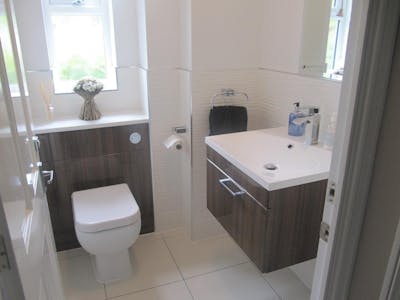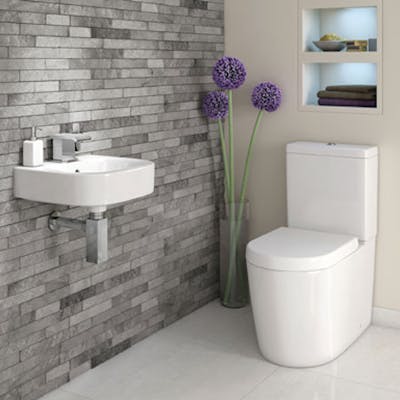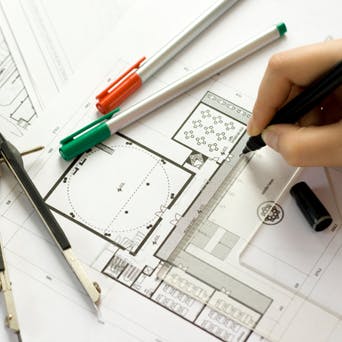Converting An Under Stairs Cupboard To A Toilet | How To Guide | More Bathrooms
Published: 14 December 2020
Many of us don’t consider how the awkward and small space under the stairs can be better utilised. Instead, it’s often left unused or as an overcrowded storage area.
If you’ve had a recent clear out, or have a growing family, converting the under stairs cupboard into a toilet can be an ideal way to make the most of the available space.
This how-to guide will help you understand what’s required when converting the under stairs cupboard to a toilet with regards to installation and building regulations, product choices and design, while highlighting the benefits of adding an additional WC to your home.
.jpg?auto=compress%2Cformat&cs=strip&ixlib=php-1.1.0&s=4d4e072693ac347f4f8c109850b60838)
Converting An Under Stairs Cupboard To A Toilet
Before planning an under stair toilet conversion, you will need to confirm whether the room is suitable for the installation of an additional WC, and that the project will comply with current building regulations.
Whilst you don’t have to acquire planning permission, building regulations to undergo an under stairs toilet conversion mean you must ensure it will have adequate ventilation and a drainage connection.
Regulations can vary depending on your location. Always check your local council rules before starting any works.
Ventilation
As the majority of under stairs cupboards don’t have a window that leads to outside, the most suitable ventilation is the installation of a fan.
There are two main fan options. Standard fans are manually turned on and off by the user by pulling a cord. A humidistat fan detects the humidity within your bathroom and automatically turns on once it reaches a certain level. It’ll then turn off when the humidity has cleared or after a set time period.
Drainage
There are two main draining options used to get rid of toilet waste:
Connecting To A Soil Pipe.
The most common way to get rid of your toilet room waste is to adapt the current soil pipe used to carry waste from other washrooms in your home. The waste will then feed to a soil stack (waste pipe) located on the side of your house.
Installation Of A Mechanical Waste Disposal Unit.
If it is difficult to connect to your current soil pipe, an alternative option is to set up a waste disposal unit within the room. This built in box collects your waste and pumps to the soil stack located on the side of your house.
What’s The Minimum Size For An Under Stairs Toilet?
Although there are no set building size regulations, our bathroom design experts advise not converting your cupboard into a toilet if you don’t have a space that measures 80 cm wide x 140 cm long.
To be able to stand within an under stairs toilet room, we recommend the minimum height for the tallest* wall to be 215cm. Abiding by these measurements will ensure you have enough space to comfortably use the toilet room.
.jpg?auto=compress%2Cformat&cs=strip&ixlib=php-1.1.0&s=e6416a9a2847c04efb0f4817cdddec50)
Electricity
To ensure you can have adequate lighting and a running fan within your toilet room, you’ll need to run electrics into the room - this is done by connecting to your existing circuit.
We recommend you install all electrical switches external to the room bearing in mind any fuse boxes located in the cupboard will also need to be moved to ensure the toilet room is compliant.
It is paramount when installing electrics in your home that you use a qualified electrician that is NICEIC approved to ensure all works are fully compliant, certified and safe.
Particularly important when adding to your existing circuit, which may result in having to update your fuse box, a qualified electrician will RCD protect the circuit and carry out a minor works test to ensure no faults are found.
Product Choices And Design Ideas
Once you’ve assessed current building regulations and installation requirements and are confident you’re fully compliant, the next stage of converting an under stairs cupboard to a toilet is deciding on your product choices and design preferences.
Unsurprisingly, the most common issue of under-stair toilet rooms is limited space, but there are a number of options that allow you to maximise your available space.
These are all things you could think about doing when
considering
smallcloakroom design ideas:
Sanitary Ware
When choosing your toilet and basin you’ll need to bear in mind the space you have available.
There is now sanitary ware that has been designed specifically for small rooms including short projection toilets.
We recommend opting for wall-hung toilets and basins to maximise available floor space. Additionally, you should hang the basin on the tallest wall in your under stairs suite to allow for as much standing space as possible when washing hands.
You can also maximise your available space by installing compact corner basins and toilets that make the most of unused corner space.
Flooring
Flooring in the under stairs cupboard usually flows directly from the flooring set up in your hallway, so there’s often no change required.
If you’re worried about any slips or falls when using your suite, there’s the option to install anti-slip vinyl flooring or non-slip bathroom tiles to the floor.

Wall Coverings
When it comes to wall coverings for a small room, we recommend considering the following design ideas:
Bold Colours.
Use bold colours to help brighten up your toilet room and boost your mood every time you nip in to use the loo.
Wall Features.
The installation of a feature wall can trick the eye into making your suite look more elongated. It’s also a great way to showcase your personality.
Light Colours.
If you want to go for a more understated design, light colours such as white, creams and beige can help to reflect light around the room, and make it feel more spacious.
Take a look at our bathroom colour guide to find out more about perfect bathroom colour combos.

Mirrors.
Mirrors can make your toilet suite feel bigger by bouncing light around the room and creating the illusion of more space.
Heating
If you wish to keep your under stairs toilet room warm there are several space saving bathroom heating solutions you can install. Depending on your preference, options include;
Underfloor Heating.
This heating solution distributes heat from under the floor, and is a great solution for toilets under the stairs as it doesn’t take up any additional space.
Towel Rails.
Towel rails help to make any suite look contemporary. Available in a range of sizes, they heat up your room whilst warming your towel. Opt for a sleek design to take up minimal floor and wall space.
Downflow Heaters.
Downflow heaters are fan heaters that are turned on and off by the pull of a connected cord. They can be fitted to a high area of the wall, making the most of unused wall space.

Lighting
When converting an under stairs cupboard to a toilet, it’s unlikely you’ll have the option to create natural light unless the space is located next to an outside wall. Even so, you’ll need to install some form of bathroom lighting to be able to use the WC at night.
Some of our favourite bathroom lighting options that you may wish to consider are:
LED Lighting.
A popular lighting option, LED lights can be installed as ceiling spotlights, wall lighting and or low level floor lighting.
Recessed Lighting.
Used to set the mood of your suite, recessed lighting is often used in bathroom niches. If your suite has the space to add this storage option, it can be a great way to add depth to your room.
Illuminated Mirror.
Illuminated mirrors can be used to light up a specific area in your toilet room, and are often incorporated into a wall cabinet.
Storage
To make the most of the available space, you could always install some clever bathroom storage furniture solutions:
Vanity Basin Units.
Vanity basin units combine your basin and storage as one. Usually wall hung they are a fantastic addition to a small suite.
Wall Cabinets.
A popular modular wall hung bathroom storage option, wall cabinets are available in a wide range of shapes, styles and sizes.
There’s also the option to fit overhead cabinets for storage of items that don’t need to be used often, allowing you to make the most of unused wall space.
Wall Niches.
Built into the wall, recessed wall niches don’t take up any outward space. We find that customers like to use wall niches as a display area for plants or sentimental items.
Benefits Of Adding An Additional WC
If you’re still unsure whether converting an under stairs cupboard to a toilet is a worthwhile project, consider these benefits of adding an additional WC to your home:
Alternative Toilet Option.
If you have a busy household, there’s nothing worse than needing to use the toilet whilst the bathroom is being occupied by somebody enjoying a long soak or using the shower. The installation of an additional toilet helps to prevent the need to compete for bathroom time.
Easy Access.
If you have a growing family or elderly parent moving in, installing a downstairs toilet creates an easy access option for those who may struggle to get up the stairs.
It’s also equally as great for young children beginning to use the toilet for the first time, who might not make the journey upstairs in time.
Visitors.
Having an alternative toilet located downstairs prevents visitors from having to walk around your home to use the loo. As mentioned above, adding colour and bold designs to your toilet room can also be a fun way to showcase your personality.
If you wish to learn more about converting an under stairs
cupboard to a toilet or require more general bathroom advice, we’re happy to
help. Call us or
book a free, no obligation design appointment with
one of our senior designers today.
Share this Post


.jpg?auto=compress%2Cformat&cs=strip&ixlib=php-1.1.0&s=4d4e072693ac347f4f8c109850b60838)
.jpg?auto=compress%2Cformat&cs=strip&ixlib=php-1.1.0&s=e6416a9a2847c04efb0f4817cdddec50)



.jpg?auto=compress%2Cformat&cs=strip&fit=clip&h=400&ixlib=php-1.1.0&w=400&s=d2efd30778c9be853eebe98f9547ae42)



















